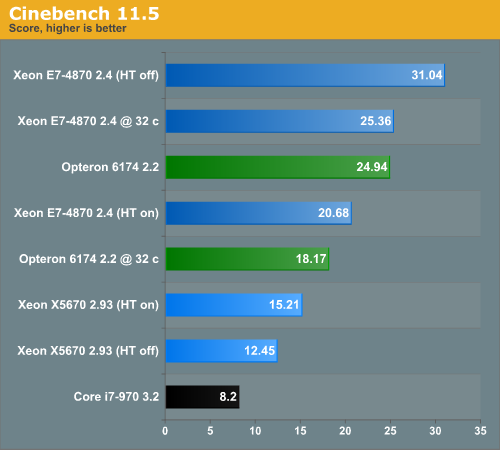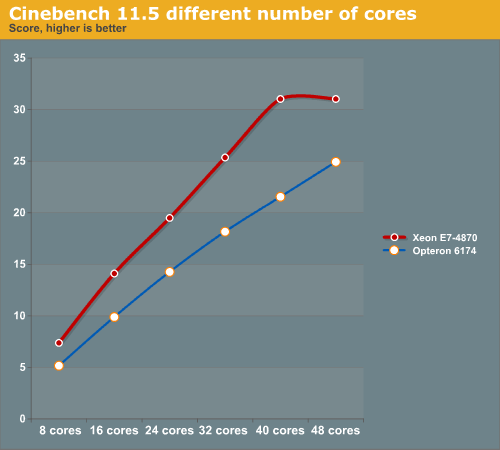Rendering and HPC Benchmark Session Using Our Best Servers
by Johan De Gelas on September 30, 2011 12:00 AM ESTCinebench R11.5
Cinebench, based on MAXON's software CINEMA 4D, is probably one of the most popular benchmarks around, and it is pretty easy to perform this benchmark on your own home machine. However, it gets a little bit more complicated when you try to run it on an 80 thread server: the benchmark only supports 64 threads.
First we tested single threaded performance, to evaluate the performance of each core.

A Core i7-970, which is based on the same "Westmere" architecture gets about 1.2 at 3.2GHz, so there is little surprise that a slightly lower clocked Xeon 5670 is able to reach a 1.15 score. It is interesting to note however that the Westmere core inside the massive Westmere-EX gets a better score than expected. Considering that Cinebench scales almost perfectly with clockspeed, you would expect a score of about 0.9. The E7 can boost clockspeed by 17% from 2.4 to 2.8GHz, while the previously mentioned i7-970 gets only an 8% boost at most (from 3.2 to 3.46GHz). And of course, the massive L3-cache may help too.
The Opteron at 2.2GHz performs like its Phenom II desktop counterparts. A 3.2GHz Phenom II gets a score of about 0.92, so we are not surprised with the 0.66 for our 2.2GHz core.
When we started benchmarking Cinebench on our Xeon E7 platform, we ran into trouble. Cinebench only supports 64 threads at the most and recognized only 32 of our 40 available cores and 80 threads. The results were pretty bad. To get a decent result out of the Xeon E7, we had to disable Hyper-Threading and we forced Cinebench to start up 40 threads. We included a Core i7-970 (Hyper-Threading on) to give you an idea of how a powerful workstation/desktop compares to these servers. This kind of software is run a lot on fast workstations after all.

Even cheap servers will outperform a typical single socket workstation by almost a factor of two. The quad socket machines can offer up to three or four times as much performance. For those of you who can't get enough: you can find some dual Opteron numbers here. The dual Opteron 6174 scores about 15, and a dual Opteron 2435 2.6 "Istanbul" gets about 9.
Cinebench scales very easily as can be noticed from looking at the 32 core and 40 core results of the Xeon E7-4870. Increase the core count by 25% and you get a 22.4% performance increase. The Opteron scales slightly worse. Compare the 48-core result with the 32 core one: a 50% increase in core counts gets you "only" a 37% increase in performance.
Below you can see the rendering performance of two top machines rendering with different numbers of cores.

You need about 48 2.2GHz Opteron cores to match 32 Xeon cores. The good news for AMD is that even these 8-core Westmere-EX CPUs are almost twice as expensive. That means that quad AMD Opteron 61xx systems are a viable choice for rendering, at least in CINEMA 4D (assuming it has the same 64-thread limitation as Cinebench). AMD has carved out a niche here, which is one reason why there will be cheaper 4 socket Romley EP systems in the near future.










52 Comments
View All Comments
Phynaz - Friday, September 30, 2011 - link
If you are overclocking in a business environment, what other moronic decisions has your company made?When does the going out of business sale start?
MrSpadge - Friday, September 30, 2011 - link
Don't condemn him blindly. By overclocking they can get substantially more performance from a similar budget. that's more efficiency - if done right.The question is "what happens in case of failure". If it's just a crashing machine, the rendering can be repeated by another one and this machine can be tuned down a bit. If it's a visual artefact during rendering, the redering can be repeated by any machine and this machine tuned down a bit. What else could go wrong in rendering? Obviously you wouldn't want to OC your web server or database..
BTW: there was an article here some time ago, showing Cyrix doing their testing on OC'ed i7s.
MrS
Kvarta - Tuesday, October 4, 2011 - link
Don't be so sure. Recently You can see standard desktop CPU beating expensive Xeons in professional applications. Example:http://www.solidworks.com/sw/support/shareyourscor...
So You don't need to buy very expensive DELL or other workstation, instead go to PC boutique near the corner :)
JohanAnandtech - Saturday, October 1, 2011 - link
This was not meant to be a professional rendering test. It was more an experiment to give the enthusiasts an idea what these servers are capable off. If you have a suggestion on which animation we should use in our benchmarking scenario's let me know. I have solid background in the "web- database - virtualization" field (I have been active in the field for more than 10 years now, teaching and consulting) , but rendering and HPC is something I only know from a benchmarking background :-).WeaselITB - Friday, September 30, 2011 - link
I'll echo the other sentiments here. If a Xeon system renders something twice as fast as the Opteron system, but takes five times the power draw to do it, it's a net-win for the Opteron system. Performance / watt would be a useful metric in these comparisons, especially as systems like these will be going in data rooms where excess wattage = excess heat = excess money.I would also be interested to know what a comparision would be between a "big iron" system like this versus a "traditional" render farm composed of some Core i7 machines.
Awesome review, though! I'm especially happy with the fact that you didn't just say "Oh, the Operteron kinda sucks in this test. Oh well." but actually took a look deeper into what's going on with the benchmark and the workload. THAT's the type of analysis that makes me keep coming back to AnandTech. :-)
Thanks,
-Weasel
JarredWalton - Friday, September 30, 2011 - link
Pretty sure perf/Watt isn't going to be in Opteron's favor, but there's a lot of stuff you need to account for. Johan did some measurements of power use on these servers previously (http://www.anandtech.com/show/4285/6), but as pointed out the Intel setup has a lot more RAS features and such that could be adding to the power use. Even so, the "load" power measured (using vAPUS, which may use less than something like 3D rendering) is around 875W (HT off) to 920W for the Intel E7-4870 server compared to around 590W for the Opteron 6174 server.In terms of perf/Watt, if those figures are relatively close for the benchmarks Johan has done here, then the best scores in Cinebench give 0.0355 CB/Watt for E7-4870 vs. 0.0425 CB/Watt for the Opteron 6174 -- and again, note that the 64-thread limit (tested with 40) means CB11.5 isn't able to make maximum use of the Intel platform. For the second test, best-case we measure 0.0194 CFD/W for Intel compared to 0.0145 CFD/W for AMD. So AMD wins in 3D rendering by 20% and Intel wins in the Euler3D CFD test by 34%, at least given the current estimates.
My gut feeling is that if all other elements and features were identical, other than the necessary chipset and CPU differences (e.g. the PSU, amount of RAM, HDDs, fans, RAS features, etc.), the difference in power draw for the two platforms should be within 100W, not the up to 340W spread measured in the earlier article. (There's also a 310W difference at idle, which gives some indication of all the other things that appear to be running on the Intel setup, as normal idle power looking at just the CPUs should be very nearly equal.) So these figures I list here are specific to the Intel Quanta QSCC-4R and Dell PowerEdge R815 and may not hold for other AMD/Intel servers. In other words, take with a grain of salt.
RandomUsername3245 - Friday, September 30, 2011 - link
The intel compiler is a very good compiler for Intel CPUs, but in the past it was well known for producing poor quality binaries for non-Intel CPUs. I would still be wary of benchmarking Intel vs. AMD when running code compiled with Intel's compiler.FWIW, I heard a while ago that Intel was "officially" going to stop artificially penalizing AMD CPUs that run Intel-compiled code.
James5mith - Friday, September 30, 2011 - link
Just a note:We are doing some in house testing for high end database testing using solid state storage connected via infiniband to multisocket servers.
An example:
Dell R910
4x 8C/16T X7560 2.26GHz Xeon CPU (32C/64T total)
512GB RAM
2x 146GB 15K SAS hdd's in RAID1 (OS)
2x Mellanox QDR Infiniband 40Gbps adapters
Hooked up to some seriously fast external flash storage, we got around 6GB/s+. This allowed us to do massively multi-threaded workloads, like building an index on a 2TB database.
During these tests, we can max out all 64 Threads and put the entire box under 100% load. It was during these tests we found out that Dell has a flawed implementation of the Intel SpeedStep technology which keeps the fans from ramping up under load.
Without the fast storage, we could never have fully stress tested the box.
mczak - Friday, September 30, 2011 - link
I think part why the opteron has bad scaling without interleaving and xeon does not is not just due to the coherence engine.Don't forget that while both have 4 sockets the Opteron is a 8 node system. The article states that there are "4 memory controllers" and "3 out of 4 operations traverse the HT link" which isn't really true as there are 8 memory controllers (and 7 out of 8 operations traverse HT, though some of them are internal HT links).
You can see that this makes a difference with the bad scaling from 6 to 12 threads (though not as bad as with even more threads...).
extide - Friday, September 30, 2011 - link
Dont forget the Xeon E7 is 4 sockets with 4 memory channels each.